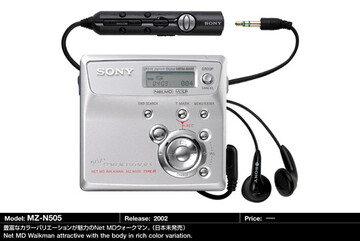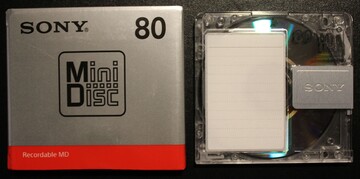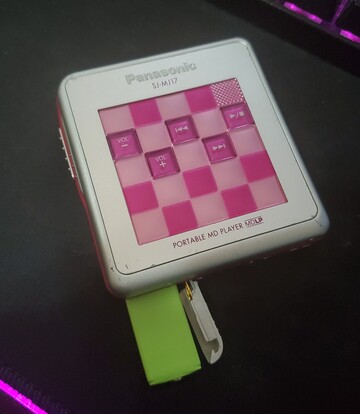Getting Started
Before we begin
Be aware that MiniDisc is not the same as 8cm Mini CDs, Nintendo GameCube discs, or Sony PSP UMDs (Universal Media Disc) - MiniDisc is a particular format, and is spelt “MiniDisc” - with a C and no space.
Background
MiniDisc is a retro-futuristic media format with near-CD quality. It was on the market from 1992-2013 and was most popular in Japan.
We highly recommend you read our Why MiniDisc? FAQ and watch the following videos from This Does Not Compute and Techmoan. If you find the format appealing after this research, we're excited to help you start collecting and enter the community. The MD scene is friendly and helpful if you have any questions.
Warning
Starting to collect MD in 2024 is not always cheap or straightforward. Because the format is discontinued, equipment is harder to find and may be damaged. While there are listings of recorders and discs that should get you started immediately, most collecting needs some research for the best deals. There is a chance that you will purchase equipment that is broken or needs repairs.
You should enjoy collecting, using, preserving, and documenting the format for this to be worth your time and money.
Collecting for aesthetics (not usage)
This guide assumes that you want to use MiniDisc as an audio format with all the functionality it had when new.
If you are only interested in the aesthetics of the format, we recommend buying a mixed lot of used discs instead of any hardware, as discs are inexpensive and not in limited supply like hardware is.
The Yandhi disc
This disc is a Muji 80 MD.
We believe it was only sold in Japan, and is quite rare - both because it didn't sell as well as bigger packs of Sony, Axia, Maxell, or TDK discs; but also due to demand from collectors.
The best place to search for one is a Japanese auction service. The MiniDisc community has been asked about this disc a lot from collectors and this is the best advice we can give.
Getting equipment
 The Sony MZ-N505, one (of many) good choices for a first device.
The Sony MZ-N505, one (of many) good choices for a first device.
What to buy
See our new Buyer's Guide for much more detailed equipment advice.
The best MiniDisc device available is the one you already have access to or can buy easily. We cover returning to MD below, for those who already have equipment or experience with the format.
NetMD recorders
If you are buying online, an obvious first MiniDisc device is a NetMD portable recorder. These devices can record music over a USB connection on any modern computer (Windows, macOS, Linux, or Android) and have better battery life and sound quality than older devices. They were among the more popular devices in North America, but are in higher demand due to their convenient features.
Older devices
But older devices should not be dismissed. Older recorders that need to record via dubbing still deliver amazing sound quality and support most of MD's advanced features such as titles and moving tracks. It is better to start collecting with an available older device than wait for a particular newer model.
Check the details of a device on the respective wiki page, and talk to us if you have any further questions before you spend money on a device. Our Discord server or Twitter are the best ways to get a fast response.
Recorder vs player
MD is a recordable format, but not all devices support recording.
Players with no recording functionality were more common in Japan than other markets, but were offered worldwide. Listings may call a recorder a player (see more on this below.) Players are designed to be secondary devices to play discs that you have recorded on other hardware. Be sure not to buy a player as a first device (unless you aim to only buy albums released by labels).
Recommended NetMD units
Device cost is currently rising, but unit, remote, dock [if applicable] should all be under US$100. Below is an incomplete list of popular recommended units. NetMD portables usually cost around the same as older ones without USB.
- MZ-N505 - Takes AA batteries, NetMD Writer
- MZ-N707 - Takes AA batteries, NetMD Writer
- MZ-NE410 - Takes AA batteries, NetMD Writer, entry-level model, no AC port
- MZ-N420D - Takes AA batteries, NetMD Writer, entry-level model, no AC port
- MZ-N510 - Takes AA batteries, NetMD Writer
- MZ-S1 - Takes AA batteries, ruggedized design.
- MZ-N910 - Late era NetMD, fast writing
- MZ-N920 - Fastest NetMD Writer
Units to avoid
Where to buy it
There are several places to find equipment, depending on your locale. You won't find MiniDisc equipment in stores that sell new electronics, nor in major online retailers.
Instead, much equipment is sold on auction sites such as eBay and Yahoo Japan Auctions (via proxy services as necessary); thrift stores such as Goodwill or Value Village; or classified ads such as Craigslist, Kijiji, or FB Marketplace. Which is most convenient and affordable for you will depend on your location.
MiniDisc enthusiast communities such as /r/MiniDisc, /r/AVExchange, and the Wiki Discord's #Buy-Sell forum also have listings. Sellers in these communities will have more knowledge about an item's condition, but also its value.
Local vs import
The local availability of MiniDisc equipment, discs, and accessories will depend on how popular MD was in your region. Japan was by far the most popular market, and the pricing and availability reflects that.
Patience can be key in some cases. Local sellers may pop up with a great deal if you're willing to shop around and monitor sites, thrift stores, or garage sales for a few weeks.
Importing a device from another country can be worthwhile, but be mindful of shipping, processing, and customs fees. These are applicable whether using a proxy service or not. Consider these before deciding to ship/import a device or not. Since the pandemic, shipping costs from Japan have increased. Expect to pay considerably more than you would have in 2019 for shipping.
If you are buying a machine from another region, be aware of differences in mains power voltages. This will almost certainly affect decks - very few models have voltage selection switches. This will also affect portables that come with AC adaptors (“power brick”) as few (if any) OEM products support multi-region voltages.
Seller listings
Sellers may list their equipment with little or misleading information. Even a device listed as working may not have been fully tested to record correctly or may have battery corrosion. Some listings will call recorders players (or vice versa). Items listed “as-is” or “junk” may work perfectly but have not been tested.
Keep this in mind when purchasing equipment, as it can lead to buying second or third devices to replace bad purchases, as donor hardware, or it can result in great deals.
Lots
Sometimes there will be sales of MD lots, including a recorder or more with discs, remotes, chargers, batteries, etc. These should be considered as it may be cheaper than individual purchases. AC adapters are very useful to have (and may be hard to find separately) while batteries will have likely failed if original.
What else to get
Discs
MiniDisc is a recordable format, so be sure to get discs (unless you aim to only buy albums released by labels). Discs are re-recordable thousands of times. For used discs, you should aim to not pay more than US$2-3 per disc, or ~JPY100 from Japan in a lot. Brand new discs (MDW80T) are still sold in Japan for ~JPY240 each and should not cost more than US$5 when imported.
There is no audio quality difference between disc types. Some models (especially Maxell) have plastic shutter covers rather than metal, although reliability does not seem affected so far.
Collecting a number of different discs is part of the format's appeal. There are a great variety of colors, manufacturers, and styles. See our disc database to see a listing of discs of many different types and styles. Please help us by adding your own!
Remotes
It is common to keep a MiniDisc portable in a pocket or bag while controlling playback via an inline remote. Most equipment does not need a remote to function, but some do (check the wiki page for a device) and others have features that are only available via the remote (many players only have screens on the remote, but do have playback buttons on the player)
Remotes bundled with a device often work with other devices by the same manufacturer, but may lack some features (no display, no access to device settings, some buttons mismatched). The wiki lists some remotes in our Accessories section.
Chargers and batteries
By far the most common batteries used by MD equipment are the Gumstick and AA cells. Original Sony NH-14WM batteries or clones bundled with devices have (almost definitely) failed by now, so you will need to buy a fresh battery.
To keep devices slim, many (but not all) MD portables use an optional Sidecar to hold a AA battery (or several). These screw onto the side of the unit and allow for an alternative power method. See our list of Sony sidecar compatibility.
We have also started an article for modern batteries for some of the oddball batteries (such as the Sony MZ-1.)
We would recommend a device that takes AA batteries to start. AA batteries are easier to find, and most North America market MD portables use AAs (check the respective wiki page for details.)
Even with new rechargeable AA batteries, a recorder may be only to record 3-6 discs per battery. Recording is much more battery-intensive than playing, and most like to plug in their recorder while writing. Keep this in mind when looking at equipment and lots. If you must use AAs to record, modern li-ion rechargeables like the Jugees available on Aliexpress will last longer due to their consistent voltage output.
Headphones
Airpods and Galaxy Buds won't work at all with MiniDisc (unless you buy a Bluetooth adapter). You will need 3.5mm headphones or a 3.5mm aux jack to connect to a portable.
Original headphones that come in a lot or with a portable may be worth preserving but not used for listening. Modern earbuds are likely to outperform the cheap ones provided with a device. Some of the over the ear headphones were especially nice, however. Find 3.5mm headphones that work well for you based on reviews and your preferences.
What is ATRAC? MDLP? NetMD? Hi-MD?
ATRAC
ATRAC is the audio compression format Sony developed to use with MiniDisc. This audio compression is how a MD can hold the same amount of audio as a CD on a much smaller disc.
Because Sony could develop dedicated chips to encode and decode ATRAC audio, it could perform very well when compared to other audio compression formats of the time.
Later MiniDisc equipment improved the quality of ATRAC encoding and decoding significantly, and you can expect better audio recording from a later device than an early one. This applies even when a disc recorded on a newer device is played back on an older one.
MDLP
MDLP (MiniDisc Long Play) is an addition to the MiniDisc format that was introduced in 2000 and allowed for 160 or 320 minutes of audio to be recorded to a standard 80 minute MD.
Sony achieved this by both using a newer compression format, ATRAC3 (not to be confused with version 3 of the original ATRAC format) and by compressing the audio further, causing reduced audio quality, especially on LP4 mode.
Audio recorded in LP mode can not be played back on non-MDLP equipment - only silence will play.
NetMD
NetMD is the branding Sony used for MiniDisc equipment that can connect to a PC and copy audio (usually with SonicStage or Simple Burner software.) Nowadays NetMD equipment is highly recommended due to the ease of copying music with new apps (Web MiniDisc and Platinum-MD), long battery life, and high sound quality.
All NetMD equipment supports MDLP, but not all MDLP equipment supports NetMD.
Hi-MD
At the end of MiniDisc's commercial life, Sony expanded the format with Hi-MD, a new standard with new recorders and discs. Even on standard MD discs, Hi-MD allowed new modes such as uncompressed audio.
Hi-MD devices are compatible with standard MiniDiscs (SP and MDLP) but Hi-MD discs and standard discs in Hi-MD format will not work on SP or MDLP device.
Today, Hi-MD devices and discs are much more expensive than standard MD equipment, and are not a recommended buy for a beginner.
Coming back to MD
For many, we used MiniDisc in the '90s or '00s and are coming back to it now. This may mean that you already have a recorder and / or discs.
If you already have a device that is not NetMD, you can still record to it in real time via dubbing (or faster for some equipment with CD copying.)
You should still test your equipment after many years of disuse, and issues such as failed batteries will still apply.
Understanding your equipment
Most MD equipment has many buttons and options that may be confusing, even for those with experience with other audio equipment.
Some of the most common confusing options are:
- AVLS: a volume limiter that was required in some territories
- Syncro rec: automatic recording when an audio signal is detected
- Group: add a song or series of songs into a navigatable group
- T mark: divide a track into two
Testing your equipment
After a device has arrived, you should test it. Open the battery cover to check for corrosion. Insert a fresh battery and a disc. Even if the disc is blank, you should hear the motor spin up and the display will say that the disc is empty. If there is music already on the disc, have a listen!
Numerous users have reported a stuck laser sled on some devices. Moving and lubing this can sometimes revive seemingly dead devices. See our guide on common issues and repairs.
Recording to a disc
You should test recording to the disc. Whether via NetMD or dubbing. Check the write-protect tab on the bottom of the disc (closed = writable; open = read-only) and that your battery is full.
Erase the disc before writing. Web MiniDisc and PlatinumMD both have options for this. The manual for your equipment (or navigating the menus) will also let you erase the disc from the recorder itself.
Once you have copied audio to a disc, use your headphones to listen back and make sure it doesn't skip, jump, or cut out.
What to do next
Saving old recordings
Whether you have uncovered your old high school mixtapes or the lot you purchased includes hours of 90s J-pop, there are discs you may want to archive before you erase them.
We have a guide to cover recording from a MiniDisc to a PC over 3.5mm, RCA, or digital audio. Many NetMD portables supported by Web MiniDisc Pro can also export raw ATRAC files via reverse-engineered exploits. See the Web MiniDisc guide for more information on this.
Expanding your collection
More equipment
A late model MD player or a deck are common additions once you decide to use MD as (one of) your primary music formats.
More discs
No MD collection would be complete with a variety of discs. Search for deals on batches of unique or interesting blanks.
Accessories
AC adapters, new batteries, remotes, fanny packs, and docks are just a few of the accessories used with MD and that may make the experience more convenient.
Pre-recorded albums
There have been hundreds of albums released on MD, both on pressed discs during the format's commercial life as well as new releases on recordable media, often with UV printing and cases with J cards. These can be very fun (and expensive!) to find and collect, as many are rare.
MiniDisc community
Contributing to the wiki
We welcome anyone making contributions to the site and expanding what we share with other MD fans. Start by reading our contribution guide.
A few ways anyone can contribute:
- Test your NetMD recording times and add them to our listings
- Take photos and add them to the equipment page for that device
- Make a user page to show off your collection
- Add an equipment page for a device we don't list or fill in gaps in our pages
Disc swaps
The MiniDisc community hosts several disc swap events each year. Sign up on Discord and be matched with someone to send a mix disc, sometimes with a particular theme. See some of the discs swapped in previous events here.
Projects
There are many modern MiniDisc projects:
3D printing
There are numerous ways 3D printing can help with the MD hobby. Here are a few projects that may be of interest or inspiration:
Development
Reverse-engineering the various protocols used by MiniDisc has become more popular. There are numerous software projects that may benefit from testing or new features added.
Our Discord's development channels are a good place to start discussing MD software development.
Repairs and replacement parts
There are some projects to produce new, replacement parts for devices that have known failures, such as gears, USB connectors, and screens. The #projects-repair forum on Discord lists many of these to follow.

